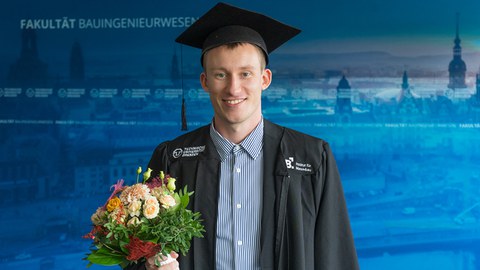Sep 20, 2024
Promotion Eric Ewert
On 19.09.2024, Mr. Eric Ewert, M.Eng. successfully defended his doctoral thesis on the topic of "Heritage-BIM - the use of digital models in the preservation of architectural monuments". In addition to the chairman of the doctoral committee, Prof. Dr. Ivo Herle (TU Dresden), Prof. Dr. Steffen Marx (TU Dresden), Prof. Dr. Ralf W. Arndt (Fachhochschule Erfurt) and Prof. Dr. Ingrid Breckner (HCU Hamburg) were present as reviewers.
Abstract:
This dissertation is about digital building models for cultural heritage and their integration into the Building Information Modeling (BIM) method. The aim of this work is to provide an approach for the holistic use of digital models in the processes of historic building conservation..
As a basis for these considerations, a requirements analysis was conducted, characterizing the planning process and records the needs of the roles involved. The necessary data was collected through guided expert interviews and analyzed using qualitative content analysis.
Based on this, the core ideas of BIM were examined regarding their applicability to heritage conservation projects. With the reverse engineering modeling of existing buildings and the need to trace the highly abstracted planning back to the real building during construction, two essential characteristics were analyzed. These can also be seen as obstacles to the establishment of a BIM approach in the future. Due to the special and sometimes controversial requirements of the stakeholders, it is necessary to integrate models of the building survey into project processes, in addition to the semantic geometry models of the conventional BIM approach. Multi-model approaches have the potential to offer valuable functionalities in the future, but they are not yet ready for use. In favor of an approach that is already available today, the option of not linking the available individual models was therefore considered in more detail. Since working with inconsistent object models contradicts one of the main intentions of BIM, deviations in this respect were understood as part of a specialized working methodology, which is referred here as Heritage-BIM (HBIM).
In the final part of this dissertation, a demonstrator project is used to illustrate how the implementation of such an HBIM approach can be realized. Based on the example of the renovation planning of the gatehouse of Ranis Castle, elements for project-specific Employer's Information Requirements (EIR) were created. BIM objectives and BIM use cases were specified and a selected use case, the deformation analysis, was examined in detail for the southern tower of the building. In addition, the model qualities required in the example were listed, thus creating comparative values for other use cases.
This thesis provides a comprehensive insight into the framework conditions of the planning process of heritage conservation concerning to the usability of digital building models. The resulting recommendations for the implementation of an adapted HBIM methodology can contribute to the far-reaching and goal-oriented integration of these models in the related practical planning and construction processes.
We would like to congratulate Eric Ewert on completing his doctorate and wish him all the best and every success in his future endeavors.

